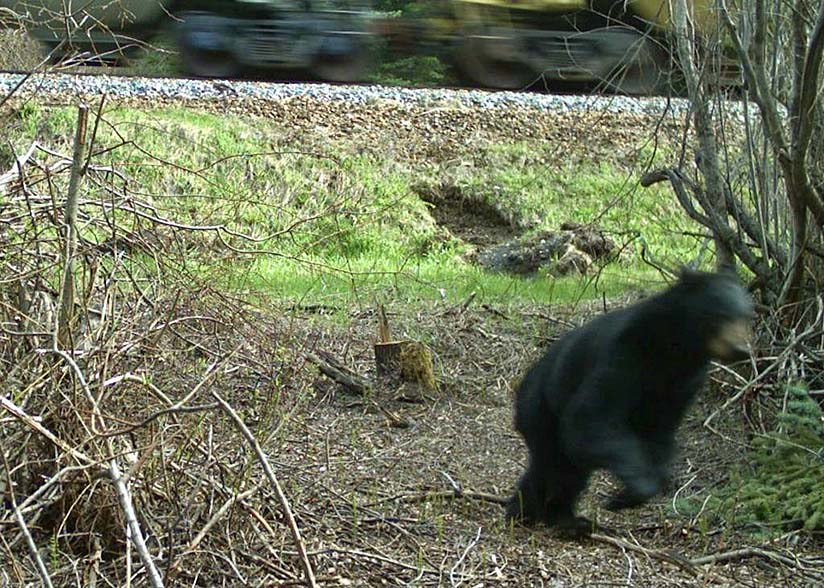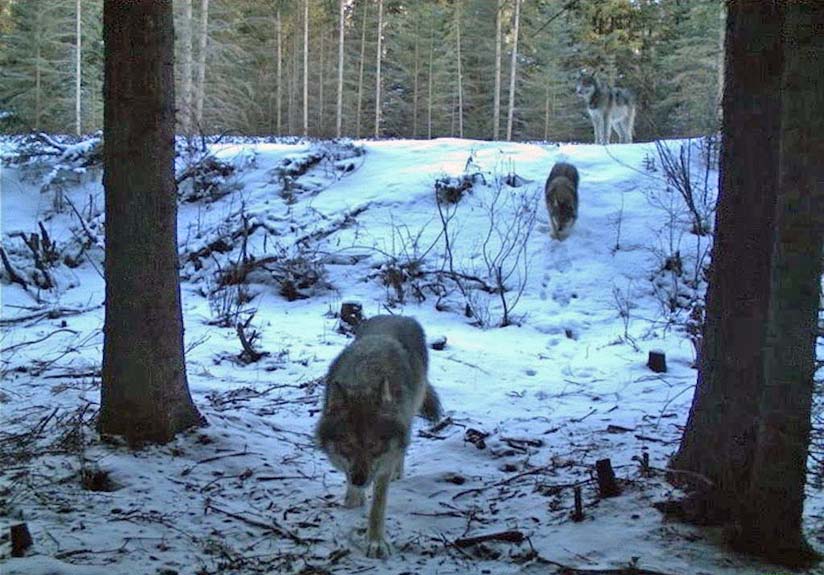
Banff Alberta - It's not your usual image of Banff National Park, but it is captivating in its own way.
In the background, there's a faint blur of a train barrelling down a wilderness track on top of a grassy, sloped hill.
In the foreground, a young black bear, caught with its hind legs on the ground and its front legs suspended in mid-air, races to safety through an opening in
the thick brush.
There are more photos just like it taken in various seasons by remote-sensing cameras.
Three wolves stroll down the same path in winter.

Countless white tailed deer and mule deer do the same thing, some walking, some running.
A bull elk, chin up, and eyes seemingly glaring at the camera, bounds by.
And at another spot in the woods, a snow covered grizzly bear ambles through a clearing.
A lynx, with a sly grin, wanders down a path among dense brush.
These photos show the results of a pilot project to decrease wildlife train mortality by creating escape trails just off railway tracks and a network of
alternative paths through the woods.
"What's beautiful about this solution is that it's incredibly low tech, it's incredibly foolproof, and it's cost effective," says Banff's resource
conservation manager Bill Hunt.
"From a Parks Canada perspective, and a Canadian Pacific Railway (CP) perspective, it's very effective and it doesn't require any on-rail
work."
CP owns the railway line through the park that's used by both freight and passenger trains.
Dozens of grizzlies have been killed in train strikes over the last decade, and anywhere from 15 to 40 animals of various species are hit each
year.
Between 2010 and 2015, Parks Canada and CP worked on a $1 million study to understand why grizzlies and trains collide, and how to reduce the
risk.
The study included research projects with the University of Alberta and University of Calgary.
In 2018, Parks Canada started a five year pilot project to clear trails near the train tracks, create egress routes, set up trail cameras, and collect
data.
Banff resource management officer Dave Garrow led a team that cleared an extensive network of wildlife trails parallel to the train tracks and created escape
routes with hand held and gas powered chainsaws, and other tools.
He says people must recognize that wildlife will always use the rails "to some degree" as travel corridors, and so there will always be animal train
strikes.
"We are hoping that we can decrease strikes on the rail, and reduce wildlife interactions with the rail," says Garrow.
As Hunt points out, people are used to seeing animal deaths along the highway, but you can't compare highways to railways.
On highways, "you see cars every three seconds," but with railways you might only see "20 to 30 trains a day so there's a lot of time where
animals can walk safely on the tracks."
Parks Canada staff put 30 remote sensing cameras along four kilometres (2.4 miles) of cleared trails and egress routes, as well as a 1.5 kilometre (almost one
mile) control area that hadn't been cleared.
"It's a very small section but the area has high mortality," says Hunt.
"Preliminary results are very promising."
As well, in November 2020, a study called "Railway mortality for several mammal species increases with train speed, proximity to water, and track
curvature", led by University of Alberta professor Colleen Cassady St. Clair, was published in Nature's Scientific Reports.
The study evaluated 646 deaths for 11 large mammal species between 1995 and 2018 in Banff and Yoho National Park.
It concluded that the top predictor for mortality sites was maximum train speed, followed by proximity to water and track curvature.
For Banff, the goal is lower rail deaths, but also fewer train strikes that cause wildlife injuries.
Hunt says "there's a human toll" from the stress felt by train engineers who hit wildlife, and parks staff who must then find the dead animal or
potentially put down an injured one.
Banff also claims to have the most numerous and varied wildlife crossing structures in the world, and supports the world's longest, year-round, monitoring
program and largest data set on wildlife migration.
The park boasts 38 wildlife underpasses and six overpasses (planted with trees and vegetation) from its east entrance in Alberta to the border of Yoho National
Park in British Columbia.
Yoho also has one underpass.
The crossings connect vital habitats and allow grizzly and black bears, wolves, coyotes, cougars, moose, elk, deer, bighorn sheep, wolverine, and lynx to
safely cross busy roads.
"There is a learning curve for animals to begin using wildlife crossings after construction," Banff staff report.
"For wary animals like grizzly bears and wolves, it may take up to five years before they feel secure using newly built crossings. Elk were the first
large species to use the crossings, even using some while they were under construction."
Research has shown that grizzlies, elk, moose, and deer prefer wildlife crossings, including overpasses, that are high, wide, and short.
Black bears and cougars seem to prefer low, narrow, and long crossings.
Highway fencing in the park has reduced wildlife-vehicle collisions by more than 80 percent, a number that climbs to 96 percent if you consider just elk and
deer.
Founded in 1885, Banff is Canada's first national park and the flagship of the national park system.
It's part of the Canadian Rocky Mountain Parks UNESCO World Heritage Site, and it draws more than three million visitors a year.
Jennifer Bain.
(because there was no image with original article)
(usually because it's been seen before)
provisions in Section 29 of the Canadian
Copyright Modernization Act.

